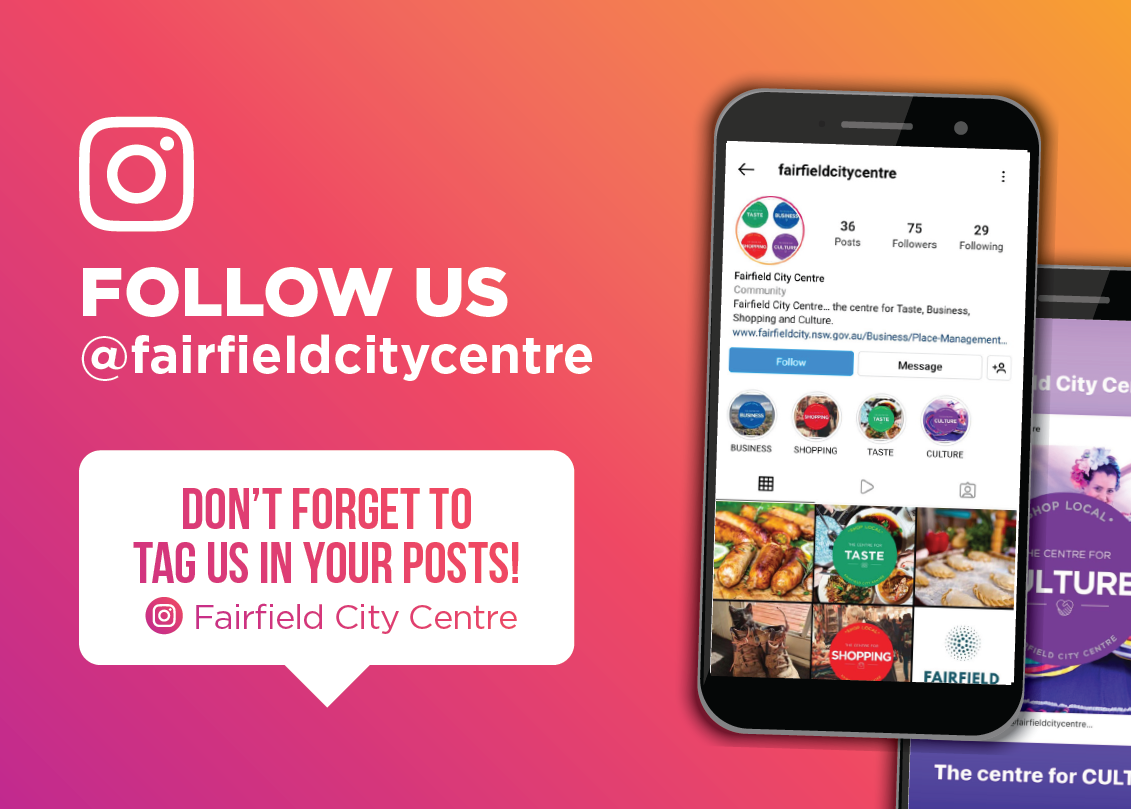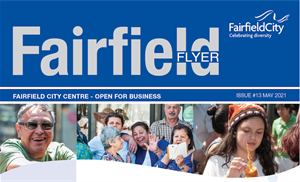Fairfield Place is situated on the eastern boundary of the Fairfield Local Government Area.
It contains substantial ‘green’ waterway corridors and recreational facilities. It has social support infrastructure but is one of the most socially and economically diverse urban communities in NSW.
The suburbs in Fairfield Place are some of the oldest in the City and therefore contain artefacts and other memorial evidence of indigenous, colonial and cultural immigration to Australia. Suburbs include Fairfield Heights, Fairfield West, Fairfield, Fairfield East, Yennora, Old Guildford, Villawood and Carramar.

Click on the image to follow us on Instagram!

The Fairfield City Centre is located upon the traditional lands of the Cabrogal people of the Darug Nation.
Fairfield is located 32km south-west of the Sydney CBD and has the largest concentration of commercial office, retail and community services in the Fairfield local government area. The Fairfield City Centre is the heart of the City, being one of the most culturally diverse cities in Australia.
The cosmopolitan Centre is bustling with local shoppers along its main street and ‘bazaar’ style retail shops during the daytime. The Centre is anchored by the commuters accessing the rail and bus services at the Fairfield railway station and bus interchange during peak times, with evenings on the weekends thriving from a myriad of wedding celebrations throughout its various function centres.
The retail focus of the Centre is driven by a local market that is focused on the intersection of Smart and Ware streets, with shopping malls to the north (Fairfield Forum built in 1982 and shifting the focus away from Ware Street) and centrally located (Neeta City opened in 1990) with a low rise commercial tower (Fairfield Chase).
The Centre is a great place to explore on foot, thanks to its interlinked streets, laneways and shopping arcades. Prospect Creek runs in a north-south direction along the eastern side of the City Centre.
The local community values public gathering and interaction, which is evident by the elderly men playing chess on Kenyon street, popular cafes and coffee shops, younger people passing through The Crescent Plaza, and the community facilities providing an enjoyable and safe meeting place for young people and others accessing the well-used library. The Centre plays host to the annual Culinary Carnival food festival in May/June, attracting approximately 5,000 visitors to the centre.

Click on the image to follow us on Instagram!
A City of New Settlement
Fairfield City is a city of new settlement. It accommodated 3,000 humanitarian arrivals in 2016: triple the usual annual humanitarian intake in 2015. Fairfield City took in 75 per cent of all Western Sydney’s refugee intake, with Liverpool City Council second at 14 per cent. Fairfield City settled at least half of Australia’s special intake of 12,000 Syrian and Iraqi refugees in 2017.
Refugees are moving to the Fairfield area with established religious and community services, family links and large existing communities after their initial arrival in other locations, some of which are interstate: a “secondary settlement” phenomenon. The need for affordable housing to accommodate larger families is required now and into the future.
Fairfield City Centre, along with Cabramatta Town Centre, contains a Centrelink office and offices of non-government organisations (NGOs) who assist in the settlement of new arrivals. This recent phenomenon has created the demand for affordable housing, office space for NGOs, and expanded community facilities. Development opportunities also provide potential community benefits to meet this demand, as well as adding to the vibrancy and importance of the Fairfield City Centre as a place to call home and a place to feel welcome, included and connected.
Fairfield City Centre Flyer
Read the latest issue here and find out what's happening at Fairfield City Centre.


There are 18 bakeries in Fairfield City Centre representing every corner of the globe. Most of the bakeries offer fresh bread straight from the oven!
Enjoy some of the authentic breads that are on offer.
Click here to access the complete online map, or click here(PDF, 11MB) to view the brochure.
This element requires javascript to be enabled.Please wait while we load your map...

The Fairfield Heights Town Centre is located upon the traditional lands of the Cabrogal people.
The Fairfield Heights Centre is a local centre within the Fairfield Local Government Area (LGA). The Centre is primarily focused along The Boulevarde, between Polding Street to the north and Beemera Street to the south. The Boulevarde intersects with Bodalla Street, Stanbrook Street, Karabar Street, Kihilla Street, Beemera Street and Station Street within the local centre area.
There are a number of retail and commercial services provided consistent with its role as a local centre. Fairfield Heights Town Centre has experienced economic decline over recent years, evidenced by shop vacancies and the transition in businesses including the closure of long standing local enterprises that also include bank branches. While the decline has impacts on the overall desirability of the centre as a destination for local shopping and community activity, there is also evidence of investment (e.g. new Woolworths supermarket), new business types (higher and ‘hipster’ café) and the ongoing presence of the Commonwealth Bank branch.
Purpose of this Study
Fairfield City Council (Council) has engaged TPG Town Planning and Urban Design (lead consultant), LFA Pacific (Urban Design) and AECgroup (Market and Economic Feasibility), to prepare an urban design study for Fairfield Heights Town Centre.
The Study has been undertaken according to the principles set out in the NSW Government’s South West District Plan. In summary, it takes a design-led planning approach that requires urban design that focuses on people in order to create great places to meet, work, exercise and socialise. This requires a holistic focus that includes: the streets, the neighbourhoods, the centres and suburbs that will be real, attractive places and provide a great liveable community for new and existing residents.